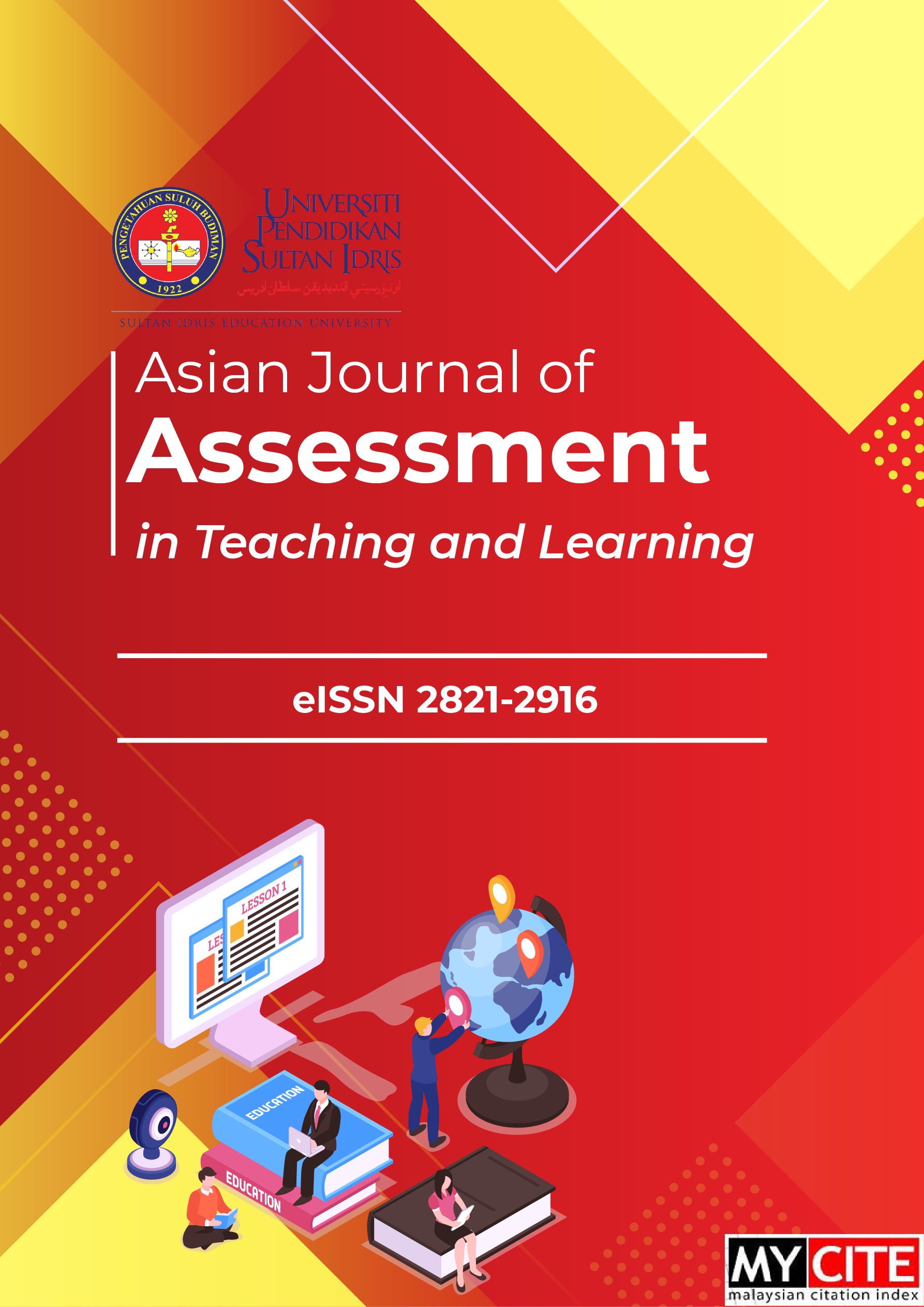Additional English Language Materials and the Learners with Disabilities’ Learning Outcomes in Malaysia: A Correlational Study
DOI:
https://doi.org/10.37134/ajatel.vol14.2.9.2024Keywords:
Special Education, Additional Materials, Learners’ Performance, Correlation AnalysisAbstract
This study explores the relationship between the use of additional instructional materials—including technological tools, pedagogical resources, and supplementary learning aids—by special education teachers and the classroom performance of learners with disabilities in Malaysia, as measured by Pentaksiran Bilik Darjah (PBD) assessments. The sample consisted of 33 special education teachers (22 females and 11 male), representing diverse teaching backgrounds and experience levels across Malaysian primary schools. Quantitative data were collected through teacher questionnaires and analysed using Spearman's rank-order correlation and chi-square tests in SPSS 20.0. The findings revealed a strong positive correlation (r = 0.757, p < 0.001) between the frequency of additional material use and learners’ performance outcomes. Furthermore, a moderate correlation (r = 0.287, p < 0.01) was identified between teachers' perceptions of learners' performance and their reported use of additional materials. These results highlight the practical significance of incorporating structured and consistent additional materials to enhance learning outcomes for students with disabilities. The study underscores the need for standardising supplementary resources to ensure equitable access and effectiveness. Policymakers and educators are encouraged to develop guidelines for integrating these materials, emphasizing their role in promoting inclusive education practices and improving learner performance.
Downloads
References
Apple, M., & Christian-Smith, L. (Eds.). (2017). The politics of the textbook. Routledge.
Berninger, V. W., & Richards, T. (2020). Teaching students with dyslexia and dysgraphia: Lessons from teaching and science. Brookes Publishing.
Butterworth, B., Varma, S., & Laurillard, D. (2021). Dyscalculia: From brain to education. Science, 371(6528), 262-266. https://doi.org/10.1126/science.aba0554
Fraenkel, J. R., Wallen, N. E., & Hyun, H. H. (2012). How to design and evaluate research in education. New York: McGraw-hill.
García, S. B., & Tyler, B. J. (2010). Meeting the needs of English language learners with learning disabilities in the general curriculum. Theory into practice, 49(2), 113-120.
Gultom, S., & Oktaviani, L. (2022). The Correlation Between Students' Self-Esteem and Their English Proficiency Test Result. Journal of English Language Teaching and Learning, 3(2), 52-57.
Haager, D., & Vaughn, S. (2013). The common core state standards and reading: Interpretations and implications for elementary students with learning disabilities. Learning Disabilities Research & Practice, 28(1), 5-16.
Harry, B., & Klingner, J. (2022). Why are So Many Students of Color in Special Education?: Understanding Race and Disability in Schools. Teachers College Press.
Ismail, A., Nordin, N. A., & Zakaria, Z. (2021). Inclusive education for children with disabilities in Malaysia: Issues and challenges. International Journal of Academic Research in Progressive Education and Development, 10(2), 153–167.
Jalalian Daghigh, A., & Abdul Rahim, H. (2021). Neoliberalism in ELT textbooks: An analysis of locally developed and imported textbooks used in Malaysia. Pedagogy, culture & society, 29(3), 493-512.
Johnson, D. C., & Bowers, E. (2020). Textbook limitations and interactive alternatives in education. Journal of Educational Research, 113(4), 234–247.
Kirk, S., Gallagher, J. J., & Coleman, M. R. (2014). Educating exceptional children. Cengage Learning.
Lee, O., & Buxton, C. (2021). Instructional resources for diverse classrooms: Beyond the textbook. Science Education International, 32(1), 20–34.
Lord, C., Elsabbagh, M., Baird, G., & Veenstra-VanderWeele, J. (2021). Autism spectrum disorder. The Lancet, 398(10309), 1512–1528.
Manap, R., Ismail, S., & Effendi, H. (2021). Curriculum adaptations for learners with disabilities in Malaysia: Challenges and perspectives. Asian Journal of Inclusive Education, 9(2), 45–60.
Manap, M. H. A., Haron, Z., & Othman, N. (2020). Penilaian pelaksanaan Program Pentaksiran Alternatif Sekolah Rendah (PASR) di sekolah rendah pendidikan khas integrasi. Jurnal Pendidikan Malaysia, 45(1 (SI)), 9-16.
McCloskey, G., & Perkins, L. A. (2021). Essentials of dyslexia assessment and intervention. John Wiley & Sons.
McGrath, I. (2021). Materials evaluation and design for language teaching (2nd ed.). Edinburgh University Press.
Musa, S. H. (2021). Something important for special education In Malaysia. Turkish Journal of Computer and Mathematics Education (TURCOMAT), 12(11), 5211-5216.
Nasir, M. N., & Efendi, N. (2021). Assessment standards for learners with disabilities: A Malaysian perspective. International Journal of Special Education, 36(1), 12–20.
Norwich, B. (2020). The relevance of the Warnock Report for inclusive education in the 21st century. British Journal of Educational Studies, 68(5), 527–542.
Raman, S. R. (2022). From Decolonization to Ethno-Nationalism: A Study of Malaysia’s School History Syllabuses and Textbooks, 27(2),1905-2020.
Shaywitz, S. E., & Shaywitz, B. A. (2020). Overcoming dyslexia: A new and complete science-based program for reading problems at any level (2nd ed.). Knopf Doubleday Publishing Group.
Schuelka, M. J., Johnstone, C. J., Thomas, G., & Artiles, A. J. (2021). The SAGE handbook of inclusion and diversity in education. SAGE Publications.
Shrum, J. L., & Glisan, E. W. (2021). Teacher’s handbook: Contextualized language instruction (6th ed.). Cengage Learning.
Thapar, A., & Cooper, M. (2020). Attention deficit hyperactivity disorder. The Lancet, 395(10222), 1240–1250.
Tolbert, S. (2015). “Because they want to teach you about their culture”: Analyzing effective mentoring conversations between culturally responsible mentors and secondary science teachers of indigenous students in mainstream schools. Journal of Research in Science Teaching, 52(10), 1325-1361.
Tomlinson, B. (2020). Developing materials for language teaching (3rd ed.). Bloomsbury Academic.
Tomlinson, B., & Masuhara, H. (2021). The complete guide to the theory and practice of materials development for language learning. Wiley-Blackwell.
Van Lier, L. (2021). Teacher autonomy in adapting and supplementing teaching materials. Language Teaching Research Quarterly, 30(2), 234–251.
Yell, M. L., Bateman, D. F., & Shriner, J. G. (2021). The law and special education (5th ed.). Pearson.
Downloads
Published
Issue
Section
License
Copyright (c) 2024 Muhammad Azwan Basaruddin, Hema Rosheny Mustafa

This work is licensed under a Creative Commons Attribution-NonCommercial-ShareAlike 4.0 International License.





